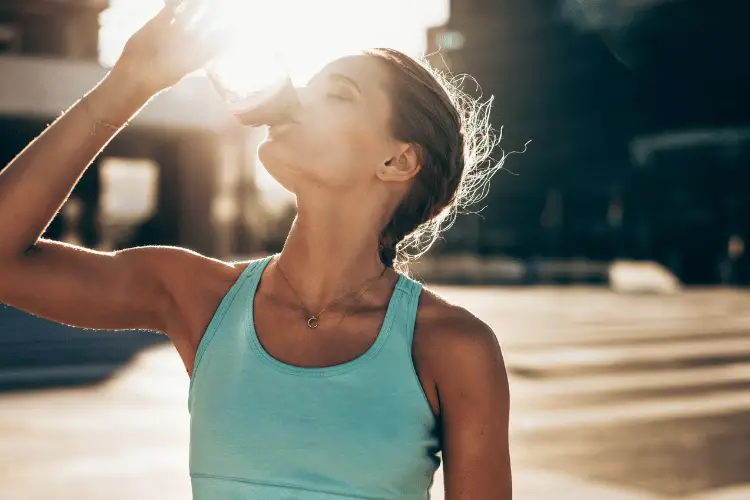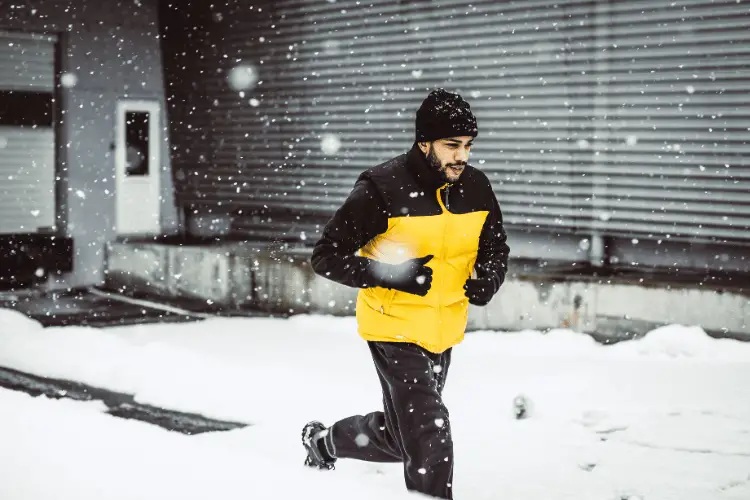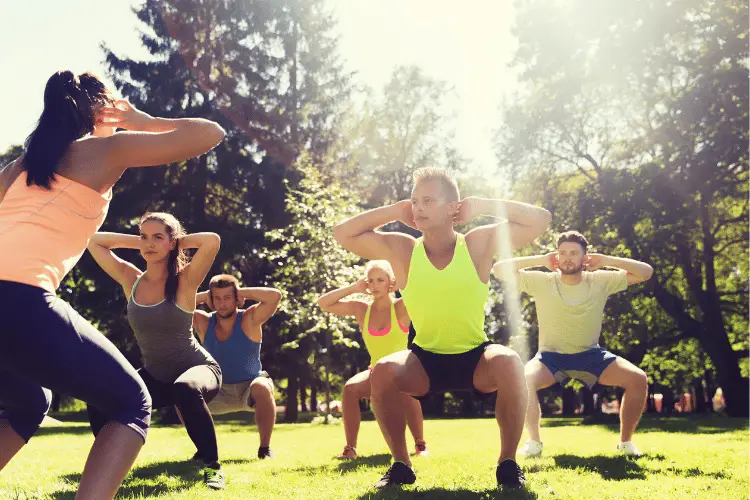Are you bored of working out indoors, whether in the gym or inside your house? Do you want to exercise where the natural elements can refresh your senses, only to find out it’s too hot or freezing cold outside?
In this scenario, it’s normal to wonder if exercising in extreme temperatures is safe.
This guide has your back because it addresses how safe it is to exercise in hot vs. cold weather. It also shares a few tips on how to safely approach this new experience and tackles whether it’s better to work out in the heat or cold.
Is It Safe to Exercise in Extremely Hot Temperatures?
Before answering this question, it’s important to specify what I mean by “extremely hot conditions.” Usually, it’s when the weather outdoors has high humidity levels, say higher than 70%, and a temperature over 90 °F (32.2 °C).
So, how safe is it to work out in such oppressive circumstances?
According to science, exercising in the heat may lead to troublesome symptoms as a result of heat stress and dehydration. Heat-related illnesses can affect your performance because they may cause:
- Dizziness
- Muscle cramps
- Vomiting
- Nausea
- Headaches
- Low blood pressure
- Fainting
What happens when you work out in hot and humid weather is that your core temperature rises, releasing more sweat than the amount of fluids that your body takes in. That’s why it’s easy for dehydration to occur at a rapid pace.
Then, at some point with extra physical activity, the excess sweat won’t be able to evaporate at a rate that suits the intensity of the exercise. This means it won’t cool your skin, which leads to heat stress and might even evolve into a heat stroke if you ignore the symptoms.
But still, does this mean that you absolutely shouldn’t work out in extreme heat? While I don’t recommend it, it’s manageable if you know how to prepare for it.
Plus, if you train your body to endure the heat, you’ll build its tolerance to gain all the positive points of working out in hot weather and minimize drawbacks. This method is better known as heat acclimatization.
You can start your journey by following a few guidelines for a safer workout session in the heat, which I’ll go through shortly.
Advantages of Exercising in the Heat
What compels many athletes to try and exercise in hot weather isn’t just the change of scenery.
Fitness lovers like the challenge, not to mention that doing physical activities in high temperatures has several benefits that you can’t ignore, such as:
- Puts extra stress on your body, which may be useful in preparing it for future physical events (running a marathon, hitting a personal fitness milestone, etc.)
- Helps boost cardiovascular fitness by increasing your blood plasma volume
- Improves blood flow for faster recovery times and lower chances of muscle aches post-workout
- Prepares you mentally for upcoming fitness challenges because it encourages you to test your strength and push your limits
4 Tips for Working Out in the Heat Safely
Because keeping your body clear of heat-related issues may be hard when it’s too warm for comfort outside, it’s time to learn four hacks to avoid the adverse effects of heat.
Tip 1: Drink Plenty of Water Before, During, and After Your Workout
Dehydration is the number one enemy for people who do outdoor activities in the heat of the summer. Add your intense exercise to the equation, and your odds of having dehydration issues will multiply.
You must drink a full glass of water before hitting the outdoors, even better if they’re two. In addition to that, don’t let the thrill of the workout distract you from drinking some water again at 15-minute intervals throughout your exercise.
Also, it’s important not to wait until you’re thirsty before hydrating your body in the heat. You don’t want to be caught off guard with mild dehydration.
Then, when you’ve wrapped up your running session or pushup sets, have a few hearty gulps to make up for all the sweat lost.

Tip 2: Always Wear the Right Workout Gear
Your choice of clothing can either make or break your outdoor exercise adventure. To ensure you don’t feel suffocated with all the gathering sweat and the pressing humidity, your workout outfit should follow these criteria:
- Choose light-colored clothes that don’t absorb heat as darker garments do.
- Go for breathable, sweat-wicking materials such as polyester, nylon, and polypropylene.
- Consider putting on loose-fitting clothes that allow the air to circulate your body and cool your sweat.
Besides clothing, your outdoor workout gear has to include a cap or visor to protect your head and eyes from the harsh sun rays.
Don’t forget to apply sunscreen to battle the harmful effects of UV rays. More importantly, try to protect your skin as much as possible by exercising in the shade.
Tip 3: Avoid the Hottest Parts of the Day
A good way to deal with insanely hot temperatures is to choose your workout times wisely and avoid going out from 9 am to 3 pm. This period is when the heat is most intense, and the chances of getting heat exhaustion are higher.
Instead, you can squeeze your outdoor workout into your morning routine because the earlier, the better. Or, if there’s no room in your schedule for a morning workout, you have sufficient time to brush up on your fitness from late afternoon until sunset.
Tip 4: Keep an Eye Out for Any Signs of Danger
Without a doubt, the most crucial tip you should keep in mind at all times is to be aware of all troublesome symptoms of heat stress. If you feel any of them while working out, don’t push yourself to finish your exercise and stop at once.
Such signs include feeling faint or nauseous, having breathing difficulties, or struggling with headaches.
If you’re stuck away from home with these symptoms, your best shot to alleviate heat stress is to enter a place with air conditioning. Get quickly inside a grocery store, coffee shop, or mall and allow your body to cool off and rest. Drink plenty of water, too.
Is It Safe to Exercise in Extremely Cold Temperatures?
While it sounds just heavenly to exercise in the freezing cold to warm yourself up, there’s still a point where the temperature can be too much to handle. Kettering Health states that you should avoid going out if it’s 18 degrees below zero or lower.
At this temperature, any exposed skin is prone to frostbite within 30 minutes or even less. You may also face other complications, like hypothermia.

This condition occurs when the body loses heat faster than it can generate it, leading to an alarmingly low body temperature. Hypothermia is even more of a concern if your workout clothes are soaking wet due to rainfall, snowfall, or the accumulation of sweat.
However, all these health risks don’t mean you can’t practice different physical activities in such cold weather. You just have to be extra cautious with your body’s exposure to the outdoor elements.
Advantages of Exercising in the Cold
Despite the hazards associated with exercising in the cold, many athletes are ready to tackle this challenge thanks to its several pros.
For example, when you work out in low temperatures:
- You can burn extra calories because your body works harder to keep you warm while providing you with energy for exercise.
- You may expect an improvement in several functions, such as your memory, focus, and decision-making skills, as one study suggests.
- You get the chance to work out for longer periods, which helps boost your endurance at a quicker rate.
4 Tips for Working Out in the Cold Safely
If it’s extremely cold outside, minimizing your chances of getting frostbite and hypothermia should be your top priority. Thankfully, multiple practices can help you avoid these worrisome scenarios.
Tip 1: Make Sure to Layer Up
Your workout gear should consist of two layers; a base layer and a top cover for protection against the cold.
When choosing clothing for the base, go for moisture-wicking options to steer clear of sweat buildup that may contribute to a lower body temperature. Don’t wear cotton, as it gathers sweat and could easily make you uncomfortable and chilly halfway through your workout.
Instead, that thin layer has to be made of synthetic materials, much like what you’d wear for exercising in hot conditions. Think along the lines of nylon and polyester.
For the top layer, aim for items that provide adequate insulation. You can drape a jacket or a sweatshirt over your base layer.
Tip 2: Cover Your Limbs, Face, and Ears
Exposed limbs like your hands are more prone to frostbite because people often forget to cover them during outdoor exercise. The same goes for your nose and ears.

The feet and toes get frostbite faster than other areas of your body. The reason is that your body focuses on heating your core in case of extremely cold conditions, leaving those limbs vulnerable.
To ward off such concerns, wear protective gear such as gloves, a face mask, a hat, goggles, and heavy socks.
Tip 3: Protect Any Exposed Skin From the Sun
If any parts of your face aren’t protected with clothing, you shouldn’t ignore using sunscreen on your skin. Even in cloudy weather, UV rays still find their way to your skin, so it’s best to be prepared.
Sure, the sun’s rays will be weaker in winter than in summer, but they can be just as harmful.
Tip 4: Don’t Forget to Drink Sufficient Amounts of Water
Similar to using sunscreen, people forget to drink plenty of water while working out in the cold. That’s because we don’t feel thirsty in winter as quickly as we do in summer. After all, our bodies don’t lose as much sweat.
Still, that doesn’t mean that the human body isn’t prone to dehydration in cold weather. In fact, some experts claim that you’re more at risk of dehydration in winter than in summer!
For that reason, you should offer your body plenty of water before you begin your workout. Remember to pepper your training session with sips, too, and drink again once you’re done.
What Is Better, Exercising in the Heat or the Cold?
Now that you know what to expect when working out in the heat and the cold, let me answer the ultimate question. Exercising in the sweltering heat vs. the biting cold—which one do I recommend?
After comparing risk factors and benefits, I’ve concluded that it’s safer to exercise in cold conditions. That is, of course, as long as you follow my safety tips to protect your body from the negative effects of low temperatures.
Working out in the cold has much fewer risks than exercising in the heat because our bodies can adapt faster to the cold and even thrive in it.
Plus, you won’t have to worry about heat exhaustion or becoming tired with exertion. When exercising in cold conditions, your body can keep going for much longer times than it can in hot, humid weather. As a result, you get the chance to build your endurance much faster.
Let’s not forget that you don’t lose as much sweat in winter, nor do you need to take as many breaks.
Exercising in the cold is also ideal for people with a history of fainting or low blood pressure. In these conditions, there are no worries about their blood pressure dropping with the heat.
To Wrap It Up
Exercising in extreme temperatures may sound intimidating at first, and rightfully so.
If you do physical activity in hot weather, your body may be prone to heat-related illnesses like heat stress or heat stroke. Similarly, working out in the cold exposes athletes to risks of hypothermia and frostbite.
Still, you may choose to exercise in such harsh conditions to reap all the benefits linked with the experience. If you’re ready to take up this challenge, you must follow a few safety precautions to battle the extreme heat and cold.
Finally, if I were to pick exercising in the heat vs. the cold, I’d always go for lower temperatures because they have much less strain on your body.
References
- https://pubmed.ncbi.nlm.nih.gov/8897321/
- https://fitness-nation.net/2021/04/16/the-pros-and-cons-of-exercising-in-the-heat/
- https://www.upmcmyhealthmatters.com/too-hot-to-exercise/#:~:text=Generally%2C%20when%20the%20heat%20index,of%20serious%20heat%2Drelated%20illnesses.
- https://www.betterhealth.vic.gov.au/health/healthyliving/heat-stress-and-exercise
- https://www.mayoclinic.org/diseases-conditions/heat-stroke/symptoms-causes/syc-20353581
- https://www.gssiweb.org/sports-science-exchange/article/sse-153-heat-acclimatization-to-improve-athletic-performance-in-warm-hot-environments
- https://www.ncbi.nlm.nih.gov/books/NBK231117/
- https://www.urmc.rochester.edu/MediaLibraries/URMCMedia/noyes/migrated-media/PT-Blog-April_1.pdf
- https://my.clevelandclinic.org/health/treatments/9013-dehydration
- https://www.phlabs.com/why-you-should-never-wait-to-feel-thirsty
- https://sciencing.com/colors-absorb-heat-8456008.html
- https://www.ncbi.nlm.nih.gov/pmc/articles/PMC5489041/#:~:text=Sunscreens%20inhibit%20the%20transmission%20of,sun%20protection%20factor%20%5B13%5D.
- https://www.realsimple.com/health/fitness-exercise/cold-weather-exercise-risks-tips
- https://ketteringhealth.org/how-cold-is-too-cold-to-exercise-outside/
- https://www.mayoclinic.org/diseases-conditions/hypothermia/symptoms-causes/syc-20352682#:~:text=Hypothermia%20is%20a%20medical%20emergency,95%20F%20(35%20C)
- https://www.ncbi.nlm.nih.gov/pmc/articles/PMC8471173/
- https://draxe.com/fitness/working-out-in-the-cold/
- https://www.inverse.com/mind-body/winter-workouts-how-cold-weather-can-supercharge-exercise
- https://www.nhs.uk/conditions/frostbite/
- https://www.mana.md/what-you-should-know-about-winter-dehydration/
- https://www.mayoclinichealthsystem.org/hometown-health/speaking-of-health/effects-of-high-temperatures-on-blood-pressure-heart


